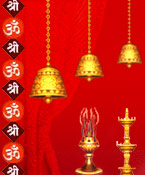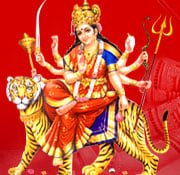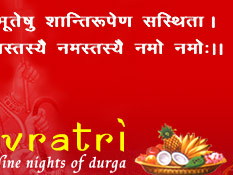We Wish you happy Navratri and Dussehramay Maa Durga bless all









 The nine different aspects of Devi are worshipped over the nine days. These are the most popular forms under which she is worshipped:
The nine different aspects of Devi are worshipped over the nine days. These are the most popular forms under which she is worshipped:








Navratri: The 9 Divine Nights
Nine Goddess
 |  |  |
 |  |  |
 |  |  |
Literal meaning – ‘nine nights’, this nine-day period from the new moon day to the ninth day of Ashvin is considered the most auspicious time of the Hindu Calendar and is hence the most celebrated time of the year. Although it has different names in different parts of India, it is celebrated by Hindus from all regions. It is celebrated with great enthusiasm as the conquest of good over evil. Every region has its own myths and reasons to explain this.

- Durga :goddess beyond reach;
- Bhadrakali the auspicious power of time;
- Amba or Jagdamba: mother of the world;
- Annapurna: giver of food and plenty;
- Sarvamangala: auspicious goddess;
- Bhairavi: terrible, fearful, power of death;
- Chandika or Chandi: violent, wrathful, furious;
- Lalita: playful; and
- Bhavani: giver of existence.
The festivities culminate on the tenth day, called variously Vijayadashmi, Dushehra when people in most parts of the country burn effigies of Ravana, Meghanatha and Kumbhakarna.
Some people fast on all nine days, eating only fruit and milk dishes. Some fast only on the eighth or ninth day. As the festival is dear to the mother goddess, on the eighth or ninth day many people invite over nine young girls from the neighborhood. These girls are treated as the goddess herself. People ceremonially wash their feet, worship them and then offer food to the "girl-goddesses" .
On the first day of the Navaratras, grains of barley are planted in the puja room of the house. A small bed of mud is prepared in which barley seeds are sown after a small puja has been performed. Every day some water is sprinkled on it. On the tenth day, the shoots are about 3 - 5 inches in length. After the puja, these seedlings are pulled out and given to devotees as a blessing from god. The seedlings are placed on their caps, behind their ears, and inside books to bring good luck. This custom suggests a link to harvesting. The sowing and reaping of barley is symbolic of the "first fruit". Soon after this festival, the sugarcane crop is harvested and the winter crops are sown.
On the first day of the Navaratras, grains of barley are planted in the puja room of the house. A small bed of mud is prepared in which barley seeds are sown after a small puja has been performed. Every day some water is sprinkled on it. On the tenth day, the shoots are about 3 - 5 inches in length. After the puja, these seedlings are pulled out and given to devotees as a blessing from god. The seedlings are placed on their caps, behind their ears, and inside books to bring good luck. This custom suggests a link to harvesting. The sowing and reaping of barley is symbolic of the "first fruit". Soon after this festival, the sugarcane crop is harvested and the winter crops are sown.
The Legend
This festival commemorates the victory of Goddess Durga over a demon, Mahishasur. Endowed with power by the blessing of Lord Shiva, the demon started destroying innocent people. The gods then invoked Goddess Durga and asked for her help. The goddess, astride a lion, fought with the demon and cut off his head.
According to one hypothesis, in ancient times, this was a festival intended for the Kshatriyas. After the four-month long monsoon when military activity was not possible, this was considered a good time to start afresh on one's conquests. For nine days before starting on the war journey, kings prayed to the nine different aspects of Devi or Adishakti. They also prayed for their arms and ammunition. The tenth day was when the journey for the conquest began.
The origin of this custom can also be traced to the Ramayana. According to it, Rama had to pray to the nine different aspects of Devi to be able to kill Ravana. He then accumulated enough power to kill Ravana on the tenth day, which was called Vijayadashmi or Victory Day. Since then, the tradition of praying to Devi for nine days has continued and was especially pronounced amongst the Kshatriyas who believed that by doing so, they too would be able to defeat the most powerful enemy.
Today, it is celebrated more for its mythological significance and reaffirms the Hindu faith in the triumph of good. Even today, the nine different forms of the goddess are worshipped. Though several communities of Hindus are staunch vegetarians, Navaratri is one exception. On the eighth day, many communities, especially Gurkha and other hill tribes who are believers in the Devi cult sacrifice an animal. This blood sacrifice is a form of thanksgiving to the goddess for a wish that has been granted. People often sacrifice a buffalo symbolic of the killing of Mahishasura by Durga
In Bengal, this period is celebrated as Durga Puja. . Groups and residents’ associations in towns and cities erect beautiful marquees, where they install the idol of the Mother Goddess. In Calcutta, as also other places, there are competitions held and the most beautiful and creatively done marquee gets a prize. For all the nine days, the marquee becomes the center of all activity where cultural events and competitions are organized every day.
In Gujarat, this is the time for the joyous Garba and Dandia dances and people pour out at night to participate in this community festival. Women and girls in all their fineries dance around the garb a pot, clapping their hands in rhythmic movement. The pot is decorated with flowers, betel leaves, and has its mouth covered with a coconut.
In Tamil Nadu, the first three days of the festival are dedicated to Lakshmi, the next three to Durga and the last three to Sarasvati. The nine-day celebration is compartmentalized in certain parts of the country, dedicating three days each to a trinity of goddesses: to Durga the goddess of valor, to Lakshmi the goddess of wealth and to Saraswati the goddess of knowledge.
The one thing that remains constant in most parts of the country is that daytime is exclusively for prayers, fasting, and solemnity while the nights are spent in joy and revelry. Men, women, and children, who have fasted during the day, have a light repast of fruit or other non-cereals at night before going out to enjoy the festive season.
In Punjab, people organize Jagrans to sing devotional songs all night in praise of the Mother Goddess. Solemnity and piety mark these nine days as even those Punjabis who do not keep a fast, stop eating non-vegetarian and impure food items like onion and garlic.
Another part of the Navratri celebrations is the Ramlila. In places like Delhi and Uttar Pradesh,almost every locality has its own group of actors re-enacting episodes from the life of Lord Rama. This is probably because, the day after Navratri, i.e. on the tenth day of Ashvin called the Vijaya Dashami, it is said that Lord Rama killed Ravana and other demons to rid the earth of evil.
Rituals
The tempo of life changes perceptibly in every family, in markets, in Mata’s temples, long before the festival commences. In homes, the corner or room reserved for puja becomes the scene of intense preparation. A coconut, saffron or sandalwood paste, a garba (perforated earthen pot), a kumbh (earthen pot), grains of wheat or barley, ghee (clarified butter) or mustard oil for a lamp that will burn incessantly all through the nine special nights, are placed in readiness for the ceremonial ritualistic initiation of the festival.
Housewives draw designs and emblems with rice flour, turmeric powder-and vermilion. Each of the motifs symbolizes abundance and represents hope for the future.
The eagerly awaited first day of the festival witnesses a flurry of ritualistic activity. On a small platform of fresh earth in front of the idol of the Mother Goddess, all the things collected for the puja are placed and the lamp is lit. As evening falls, people gather around the sacred flame that is constantly fed with ghee or oil, and soon, mellow voices singing bhajans can be heard from home after home.
On Lalita Panchami (the fifth day), children gather all the books in the house before a sacred lamp and invoke the blessings of Saraswati. It is also the occasion for all artisans to lay down their tools before the goddess and seek her benediction upon their trade.
On the eighth and ninth days of the festival, yagnas are performed as a final act of farewell that marks the termination of the ceremonies. Ghee or clarified butter, a sweet concoction of rice cooked in condensed milk (paayas or kheer) and sesame seeds are traditional items used in the yagna to the chanting of mantras conveying the theme–"This is my offering to God".
On the tenth day or Vijaya Dasami, more popularly known as Dussehra, enormous effigies of Ravana stuffed with firecrackers are torched with flaming arrows to the delight of throngs of revelers.
People read "The Devi Mahatmyam" (Glory of Divine Mother) having 700 Mantras on Shri Durga Mata.
5 Things you need to know about
"Nava-ratri" literally means "nine nights." This festival is observed twice a year, once in the beginning of summer and again at the onset of winter.
What's the Significance of Navratri?
During Navaratri, we invoke the energy aspect of God in the form of the universal mother, commonly referred to as "Durga," which literally means the remover of miseries of life. She is also referred to as "Devi" (goddess) or "Shakti" (energy or power). It is this energy, which helps God to proceed with the work of creation, preservation and destruction. In other words, you can say that God is motionless, absolutely changeless, and the Divine Mother Durga, does everything. Truly speaking, our worship of Shakti re-confirms the scientific theory that energy is imperishable. It cannot be created or destroyed. It is always there.
Why Worship the Mother Goddess?
We think this energy is only a form of the Divine Mother, who is the mother of all, and all of us are her children. "Why mother; why not father?", you may ask. Let me just say that we believe that God's glory, his cosmic energy, his greatness and supremacy can best be depicted as the motherhood aspect of God. Just as a child finds all these qualities in his or her mother, similarly, all of us look upon God as mother. In fact, Hinduism is the only religion in the world, which gives so much importance to the mother aspect of God because we believe that mother is the creative aspect of the absolute.
Why Twice a Year?
Every year the beginning of summer and the beginning of winter are two very important junctures of climatic change and solar influence. These two junctions have been chosen as the sacred opportunities for the worship of the divine power because:
(1) We believe that it is the divine power that provides energy for the earth to move around the sun, causing the changes in the outer nature and that this divine power must be thanked for maintaining the correct balance of the universe.
(2) Due to the changes in the nature, the bodies and minds of people undergo a considerable change, and hence, we worship the divine power to bestow upon all of us enough potent powers to maintain our physical and mental balance.
Why Nine Nights & Days?
Navaratri is divided into sets of three days to adore different aspects of the supreme goddess. On the first three days, the Mother is invoked as powerful force called Durga in order to destroy all our impurities, vices and defects. The next three days, the Mother is adored as a giver of spiritual wealth, Lakshmi, who is considered to have the power of bestowing on her devotees the inexhaustible wealth. The final set of three days is spent in worshipping the mother as the goddess of wisdom, Saraswati. In order have all-round success in life, we need the blessings of all three aspects of the divine mother; hence, the worship for nine nights.
Why Do You Need the Power?
Thus, I suggest you join your parents in worshipping "Ma Durga" during the Navaratri. She will bestow on you wealth, auspiciousness, prosperity, knowledge, and other potent powers to cross every hurdle of life. Remember, everyone in this world worships power, i.e., Durga, because there is no one who does not love and long for power in some form or the other.
Let us all take a resolve, this Navaratri, to spread peace, harmony and knowledge in this world and strengthen our commitment to making this world a better place.
Karmaniye wadhikaraste
R.RAMNATH&FLY









